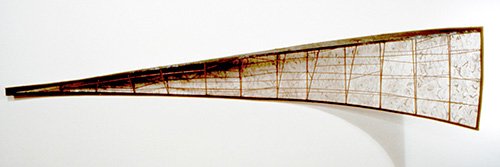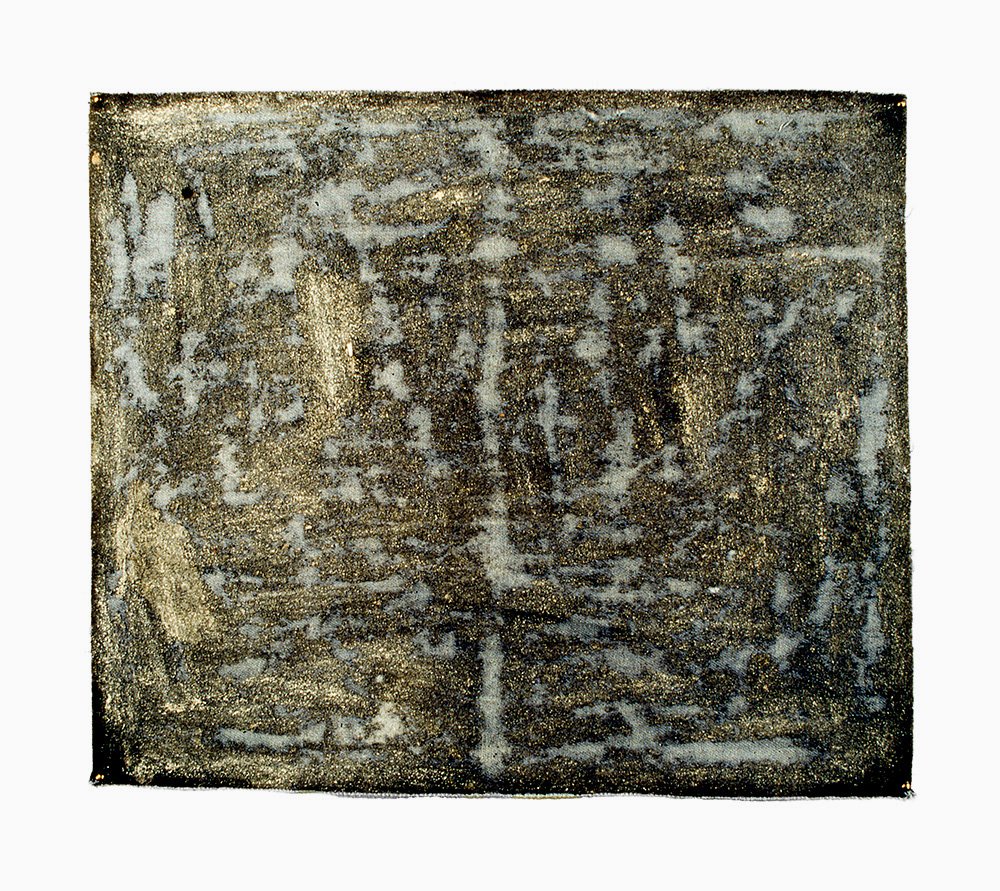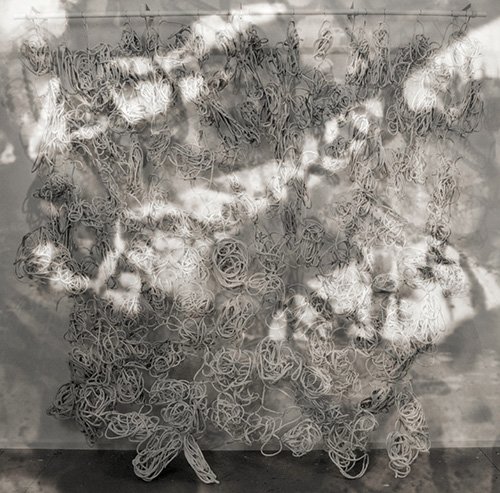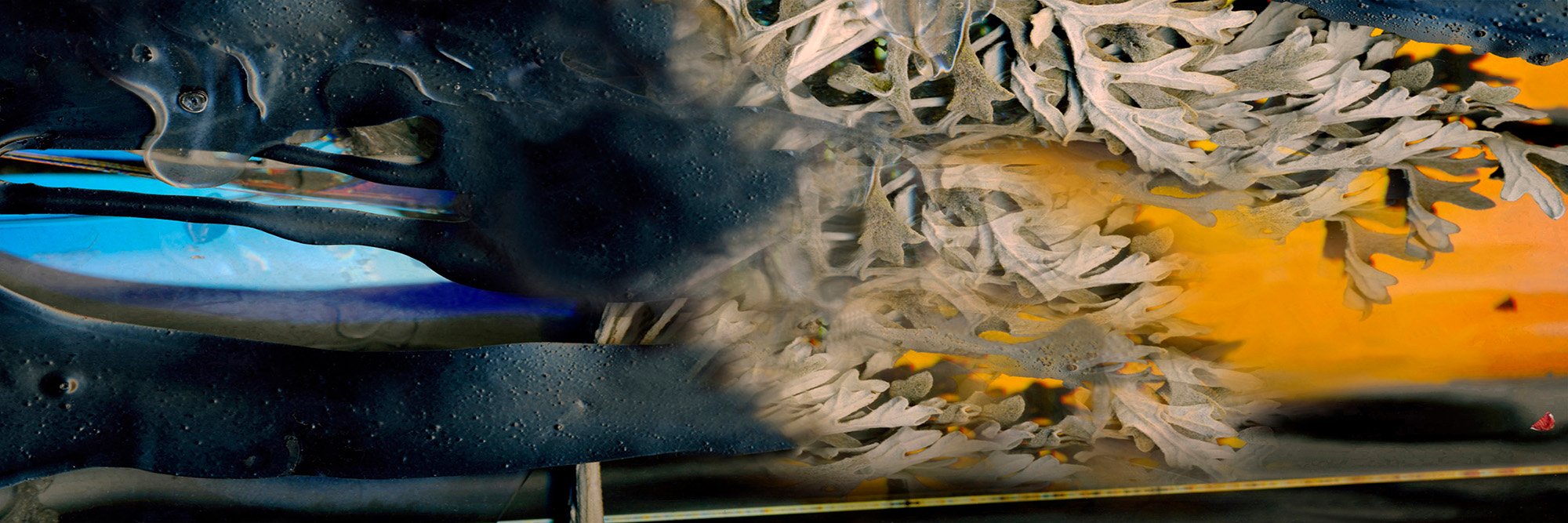Early influences in the beginning
Following one’s intuition, the exploitation of accident, and the juxtaposing of imagery were early strategies in my practice. Works by Dali, Ernst, Magritte, and Tanguy had an initial impact, which was later intensified after seeing the work of the female Surrealists, notably Dorothea Tanning, Leonora Carrington, and Méret Oppenheim.
Going to New York from painting to sculpture
It was in the work of Lee Bontecou where I discovered a stitch was a three-dimensional mark. This revelation moved my practice from painting to sculpture by way of drawing. Mark making became the vehicle for my explorations and the thread that would hold my studio practice together.
By 1985 my sculpture process had the immediacy and intimacy of drawing, producing objects that were the result of interrelated mark making. This led me to consider the anatomy and mechanics of drawing, its parts and developmental sequence. How could erasure or a ghost (after) image be conveyed three-dimensionally?
Drawing is primary, not preliminary.
During this time, I began to notice that the Emery cloth used in sanding was recording the process as it captured the multiple scratches made by dowels and varying glue and paint drops that occurred during the development of each piece. In 1987, the process was modified removing the need of Emery cloth and concluding this brief documentation.
Lower Hudson Valley return to painting
Moving from Manhattan to the Lower Hudson Valley adjacent to a wildlife conservancy in 1990, introduced me to a full spectrum of transitional patterns occurring in Nature. One striking example was Duckweed, which has a fluid or fluctuating pattern. Could a static art form have or suggest multiple identities?
Since 1996, my work has been informed by the late ink drawings of Vincent van Gogh, specifically his “mark”, which exists simultaneously as a gesture and pattern unit. It is this perceptual occurrence known as synchronous viewing that animates the composition thus perpetually engaging the viewer. My exploration of van Gogh’s mark would ultimately lead to the development of the Dimensional Drawing Project, a traveling exhibition of “drawing kits” installed by student teams and supervising faculty that would occur at nine venues over an eight-year period.
After 9/11 a renewal and return to sculpture
The Constellations series 1941-43 by Alexander Calder, a hybrid between drawing and sculpture, renewed interest in sculpture.
The 1922 Telephone Paintings of László Moholy-Nagy were an act of disengagement by establishing a distance of time and space between the artist and the creative act. Could I develop a studio strategy that would detach myself from the physical control of creating? I found a parallel with music.
Dimensional Drawings
Instead of focusing on the hand/wrist movement that creates a mark as in Grid, Segment explores contour drawing through arm/shoulder motions. Though the emphasis in the Squiggle is how a mark becomes a pattern, Rhapsody ignores the individual mark, in favor of an accumulation of marks occurring during a specific period of time. In turn, these marking episodes become a drawing unit collectively constructing a drawing either sequentially on the wall, dispersed on the floor or stacked in layers.
In Drawing Curtain, the video overlay functions as memory defining the knotted rope installation cascading in front of the wall.
My investigation started with marks becoming a pattern followed by marking episodes as marks becoming a pattern to seeing patterns as marks collectively constructing a pattern.
Printmaking a separate but related avenue of expression
During the summer of 2006, I began developing a series of monotypes in much the same way I work in other disciplines, by pursuing an idea through time. Additionally, I wanted my prints to be an autonomous but related branch of my practice, not reproductions of other endeavors.
Integrating my various mark making activities into a set of related prints was the initial concept for my first limited edition print portfolio, the Squiggle Suite. The format was borrowed from earlier diptych monotypes, balancing a “marking” plate against an embossed plate. Impressions on the plate were made by selections of remnants from my sculpture process; drops of dried glue, fragments of acrylic-paper coating, and rope tips. The change in the suite of eight occurs chronically with the marking plate moving from marks made by my hand to renderings by its digital surrogate, eventually creating a cycle of hand to surrogate to hand in the process.
Entering the Digital Age new ways of seeing
In 2010 I began what would become a category of digital drawings, produced either through motion capture or by layering episodes of past marking activities. Some of the discoveries that came from this new way of seeing would inform other areas of my practice, altering their directions.














